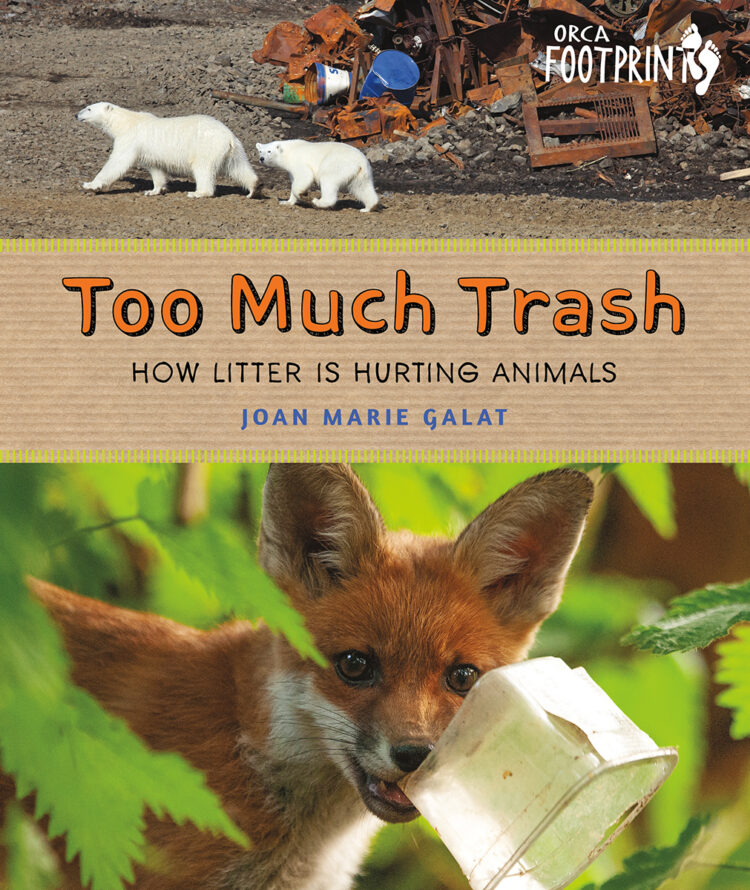 Welcome to Cantastic Authorpalooza, featuring posts by and about great Canadian children’s book creators! Today’s guest: Joan Marie Galat. I recommended Joan’s newest book, Mortimer: Rat Race to Space already this week; today, this prolific author is here to discuss a nonfiction title that sounds amazing. Take it away, Joan!
Welcome to Cantastic Authorpalooza, featuring posts by and about great Canadian children’s book creators! Today’s guest: Joan Marie Galat. I recommended Joan’s newest book, Mortimer: Rat Race to Space already this week; today, this prolific author is here to discuss a nonfiction title that sounds amazing. Take it away, Joan!
Did you know litter on the ground often ends up in water? It can travel from creeks to rivers, and onward to the sea. When I first dreamed of becoming an author, I didn’t exactly picture myself writing a children’s book about garbage, but the time came when it seemed like the perfect thing to do.
Trash on the ground and in waterways has troubled me for a long time. Like a great many others, I find it upsetting that sea turtles mistake plastic bags for jellyfish, dogs injure their paws on littered shards of glass, and cows die from licking automotive batteries left in farm fields. I grit my teeth when gulls outside fast-food restaurants stalk me for fries, or squirrels wait for me to leave my picnic table.
Species that seek litter and consume human foods don’t get the natural nutrients they need to thrive. Consuming indigestible objects—like plastics—can make their stomachs feel so full, they stop eating and die of starvation.
In a problem close to littering, people sometimes toss ducks and other waterfowl bread or popcorn, feeling they are helping. Like littering, however, feeding wildlife is harmful. (National Geographic offers a quick summary on why feeding ducks is a problem.) Animals that grow accustomed to receiving food or ingesting litter, like sea lions and deer, can become aggressive toward people. They may also harm one another when competing for handouts or garbage.
Despite my strong feelings on litter, the idea to write a book on how it impacts animals and their habitats needed to percolate. It was essential for me to figure out the best way to raise the topic for my target audience—children ages 8-12. How could I present the troubling things happening to animals in ways that would not make readers want to close the book?
In the end, I overcame the challenge using the same approach as the problem-solvers I researched—take this giant issue and make it smaller. Too Much Trash—How Litter is Hurting Animals is broken into sections that profile wildlife, pets/farm animals, and ocean species. I examine the scope of the problem, how it can be fixed, and the unique and creative solutions people are finding to protect animals and habitats from harmful litter. The book delivers the promising messages that solutions exist and everyone can make a difference.
Too Much Trash is part of the Orca Footprints nonfiction series for middle-grade readers. With photographs throughout, it examines how garbage hurts animals and their habitats, and answers questions about an important environmental issue. It is scheduled for release May 16, 2023, and pre-orders are now available through Orca Book Publishers, Amazon, and other bookstores. Where possible, please support your local independent bookseller.
Joan Marie Galat is the author of more than 25 books in eight languages. Published by National Geographic Kids, Scholastic, DCB, and others, she explores science themes relating to ecology, astronomy, space, engineering, and other topics. Too Much Trash is her first Orca title. Joan offers in-person and virtual presentations and workshops, as well as corporate training. She writes from just outside Edmonton in an office shared with two noisy budgies.
A very interesting and thought provoking article.
I look forward to picking up a copy of Too Much Trash just as soon as it’s av!
A very interesting and thought provoking article.
I look forward to picking up a copy of Too Much Trash just as soon as it’s av!